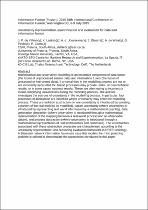 ResearchSpace
ResearchSpace
Uncertainty representation, quantification and evaluation for data and information fusion
JavaScript is disabled for your browser. Some features of this site may not work without it.
- ResearchSpace
- →
- Research Publications/Outputs
- →
- Conference Publications
- →
- View Item
| dc.contributor.author |
De Villiers, Johan P

|
|
| dc.contributor.author |
Laskey, K

|
|
| dc.contributor.author |
Jousselme, A-L

|
|
| dc.contributor.author |
Blasch, E

|
|
| dc.contributor.author |
Pavlin, G

|
|
| dc.contributor.author |
Costa, P

|
|
| dc.date.accessioned | 2016-10-13T13:37:32Z | |
| dc.date.available | 2016-10-13T13:37:32Z | |
| dc.date.issued | 2015-07 | |
| dc.identifier.citation | De Villiers, J.P., Laskey, K., Jousselme, A-L, Blash, E., Pavlin, G., and Costa, P. 2015. Uncertainty representation, quantification and evaluation for data and information fusion. In: Information Fusion (Fusion), 2015 18th International Conference on Information Fusion, Washington DC, 6-9 July 2015 | en_US |
| dc.identifier.issn | 978-147997-4047 | |
| dc.identifier.uri | http://ieeexplore.ieee.org/stamp/stamp.jsp?arnumber=7266543 | |
| dc.identifier.uri | http://hdl.handle.net/10204/8826 | |
| dc.description | Information Fusion (Fusion), 2015 18th International Conference on Information Fusion, Washington DC, 6-9 July 2015. . Due to copyright restrictions, the attached PDF file only contains the abstract of the full text item. | en_US |
| dc.description.abstract | Mathematical and uncertainty modelling is an important component of data fusion (the fusion of unprocessed sensor data) and information fusion (the fusion of processed or interpreted data). If uncertainties in the modelling process are not or are incorrectly accounted for, fusion processes may provide under- or overconfident results, or in some cases incorrect results. These are often owing to incorrect or invalid simplifying assumptions during the modelling process. The authors investigate the sources of uncertainty in the modelling process. In particular, four processes of abstraction are identified where uncertainty may enter the modelling process. These are isolation abstraction (where uncertainty is introduced by isolating a portion of the real world to be modelled), datum uncertainty (where uncertainty is introduced by representing real world information by a mathematical quantity), data generation abstraction (where uncertainty is introduced through a mathematical representation of the mapping between a real-world process and an observable datum), and process abstraction (where uncertainty is introduced through a mathematical representation of real world entities and processes). The uncertainties associated with these abstraction processes are characterised according to the uncertainty representation and reasoning evaluation framework (URREF) ontology. A Bayesian network information fusion use case that models the rhino poaching problem is utilised to demonstrate the taxonomies introduced in this paper. | en_US |
| dc.language.iso | en | en_US |
| dc.relation.ispartofseries | Worklist;16105 | |
| dc.subject | Data fusion | en_US |
| dc.subject | Sensor data | en_US |
| dc.subject | Modelling processes | en_US |
| dc.title | Uncertainty representation, quantification and evaluation for data and information fusion | en_US |
| dc.type | Conference Presentation | en_US |
| dc.identifier.apacitation | De Villiers, J. P., Laskey, K., Jousselme, A., Blasch, E., Pavlin, G., & Costa, P. (2015). Uncertainty representation, quantification and evaluation for data and information fusion. http://hdl.handle.net/10204/8826 | en_ZA |
| dc.identifier.chicagocitation | De Villiers, Johan P, K Laskey, A-L Jousselme, E Blasch, G Pavlin, and P Costa. "Uncertainty representation, quantification and evaluation for data and information fusion." (2015): http://hdl.handle.net/10204/8826 | en_ZA |
| dc.identifier.vancouvercitation | De Villiers JP, Laskey K, Jousselme A, Blasch E, Pavlin G, Costa P, Uncertainty representation, quantification and evaluation for data and information fusion; 2015. http://hdl.handle.net/10204/8826 . | en_ZA |
| dc.identifier.ris | TY - Conference Presentation AU - De Villiers, Johan P AU - Laskey, K AU - Jousselme, A-L AU - Blasch, E AU - Pavlin, G AU - Costa, P AB - Mathematical and uncertainty modelling is an important component of data fusion (the fusion of unprocessed sensor data) and information fusion (the fusion of processed or interpreted data). If uncertainties in the modelling process are not or are incorrectly accounted for, fusion processes may provide under- or overconfident results, or in some cases incorrect results. These are often owing to incorrect or invalid simplifying assumptions during the modelling process. The authors investigate the sources of uncertainty in the modelling process. In particular, four processes of abstraction are identified where uncertainty may enter the modelling process. These are isolation abstraction (where uncertainty is introduced by isolating a portion of the real world to be modelled), datum uncertainty (where uncertainty is introduced by representing real world information by a mathematical quantity), data generation abstraction (where uncertainty is introduced through a mathematical representation of the mapping between a real-world process and an observable datum), and process abstraction (where uncertainty is introduced through a mathematical representation of real world entities and processes). The uncertainties associated with these abstraction processes are characterised according to the uncertainty representation and reasoning evaluation framework (URREF) ontology. A Bayesian network information fusion use case that models the rhino poaching problem is utilised to demonstrate the taxonomies introduced in this paper. DA - 2015-07 DB - ResearchSpace DP - CSIR KW - Data fusion KW - Sensor data KW - Modelling processes LK - https://researchspace.csir.co.za PY - 2015 SM - 978-147997-4047 T1 - Uncertainty representation, quantification and evaluation for data and information fusion TI - Uncertainty representation, quantification and evaluation for data and information fusion UR - http://hdl.handle.net/10204/8826 ER - | en_ZA |





